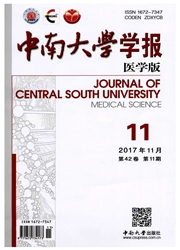

 中文摘要:
中文摘要:
目的:探讨galectin-7和S100A9表达与宫颈鳞癌发生、发展的关系。方法:采用免疫组织化学法检测243例宫颈上皮内瘤变(CIN)及宫颈鳞癌标本中galectin-7和S100A9的表达情况,结合临床病理资料,分析其与宫颈鳞癌发生、发展的关系。结果:Galectin-7和S100A9在CIN及宫颈鳞癌中表达差异有统计学意义(均P〈0.05),galectin-7在正常宫颈组织、CIN I级、CIN II 级、CIN III级、宫颈鳞癌中阳性表达率分别为56.7%,41.9%,32.0%,27.3%,25.0%,组间比较发现galectin-7在正常宫颈组织与宫颈鳞癌中表达差异有统计学意义(P〈0.0045)。S100A9在正常宫颈组织、CIN I级、CIN II 级、CIN III级、宫颈鳞癌中阳性表达率分别为80.0%,77.4%,48.0%,27.3%,20.2%,组间比较发现S100A9在正常宫颈组织与CIN III级、正常宫颈组织与宫颈鳞癌、CIN I级与CIN III级、CIN I级与宫颈鳞癌、CIN II级与宫颈鳞癌中表达差异均有统计学意义(均P〈0.0045)。Galectin-7与S100A9在CIN及宫颈鳞癌中表达呈正相关,但关系较弱(rs=0.298,P〈0.001)。Galectin-7和S100A9表达均与宫颈鳞癌临床分期、淋巴结转移有关(均P〈0.05),而与年龄、分化程度无关(P≥0.05);galectin-7表达与宫颈鳞癌患者预后有关(P〈0.05)。单因素Cox回归分析示国际妇产科联盟(FIGO)分期、淋巴结转移及galectin-7与宫颈鳞癌患者5年生存率有关,多因素Cox分析进一步验证了这一结果。结论:Galectin-7和S100A9表达与宫颈鳞癌发生、宫颈鳞癌临床分期、淋巴结转移有关,galectin-7表达可能还与宫颈鳞癌患者预后有关。宫颈鳞癌患者长期生存时间与FIGO分期、淋巴结转移及galectin-7的表达有关。
 英文摘要:
英文摘要:
Objective:To observe the correlation between the expression of galectin-7 and S100A9 with the development of cervical squamous carcinoma.Methods:Immunohistochemical SP staining was used to detect the expression of galectin-7 and S100A9 in 243 patients with cervical intraepithelial neoplasia (CIN) or cervical squamous carcinoma. The association of clinical data with galectin-7 and S100A9 expression was examined. Results:The expression of galectin-7 and S100A9 in CIN and cervical squamous carcinoma was signiifcantly different (P〈0.05). The positive rates of galectin-7 in normal cervical tissues, CIN I, CIN II, CIN III, and cervical squamous carcinoma were 56.7%, 41.9%, 32.0%, 27.3%, and 25.0%, repectively. Statistic analysis found significant difference between the normal cervical tissues and cervical squamous carcinoma (P〈0.0045). The positive rates of S100A9 in CIN I, CIN II, CIN III, and cervical squamous carcinoma were 80.0%, 77.4%, 48.0%, 27.3%, and 20.2%. Statistic analysis showed significant difference between the normal tissues and CIN III, the normal cervical tissues and cervical squamous carcinoma, CIN I and CIN III, CIN I and cervical squamous carcinoma, CIN II and cervical squamous carcinoma (P〈0.0045). A positive correlation was found between galectin-7 and S100A9 expression in CIN and cervical squamous carcinoma (rs=0.298, P〈0.001). Expressions of both galectin-7 and S100A9 in cervical squamous carcinoma were associated with the clinical stage and lymph nodes (P〈0.05), but not with patient's age and degree of differentiation (P〉0.05). Expression of galectin-7 was associated with the survival rate of patients with cervical squamous carcinoma (P〈0.05). Univariate analysis of Cox proportional hazards regression model revealed that the FIGO stage, lymph nodes metastasis, and the expression of galectin-7 were relevant to the 5 year survival rate of patients with cervical squamous carcinoma, which was comifrmed by multiple analysis of Cox proportional ha
 同期刊论文项目
同期刊论文项目
 同项目期刊论文
同项目期刊论文
 High Expression of SOX2 and OCT4 Indicates Radiation Resistance and an Independent Negative Prognosi
High Expression of SOX2 and OCT4 Indicates Radiation Resistance and an Independent Negative Prognosi Association between mismatch repair gene andirinotecan-based chemotherapy in metastatic colon cancer
Association between mismatch repair gene andirinotecan-based chemotherapy in metastatic colon cancer 期刊信息
期刊信息
